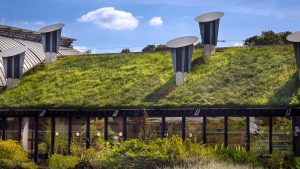 Traditionally, buildings have been thought of as static structures that remain as they are until a person or organization has them remodeled or torn down. In many cases, buildings are a relic of the past, showcasing forgotten architecture and engineering designs of the time they were built. This view, however, is slowly changing.
Traditionally, buildings have been thought of as static structures that remain as they are until a person or organization has them remodeled or torn down. In many cases, buildings are a relic of the past, showcasing forgotten architecture and engineering designs of the time they were built. This view, however, is slowly changing.
The push for building engineering that uses green, sustainable, eco-friendly concepts has seen a rise in recent years, indicating an increasing interest in these projects. Although traditional building standards may not disappear any time soon, it seems that living, regenerative, and adaptive buildings will indeed play a part in the future of engineering.
What are Living, Regenerative, and Adaptive Buildings?
While green building initiatives are important, the concept of regenerative, adaptive, and living buildings take green concepts even farther. These building standards are environmentally interactive rather than responsive and feature dynamic, changeable elements. They also aim to restore environmental factors and become fully integrated with the surrounding natural world.
Living Buildings
A living building is a structure that strives to be self-reliant and obtain all resources necessary to function from natural resources. For example, a living building uses rainwater, wind, and sunlight to generate power and provide utilities to its inhabitants.
They sometimes aim to use the bare amount of square footage necessary to conserve land and promote off-the-grid living. The goal of a living building is to produce a net-zero impact on the planet and put back whatever it uses into the environment in a safe way.
Regenerative/Restorative Buildings
Regenerative and restorative buildings aim to improve the natural environment by restoring or adding regenerative properties to the area. Regenerative engineers create buildings that restore wildlife habitat or structure to damaged environmental areas.
Their goal is to create sustainability in the built environment to create a positive impact. This type of building goes beyond green building certifications and seeks to add to an environmental center with design and construction that gives back or improves its surroundings.
Brownfields, greyfields, or previously developed sites are examples of areas where you can build a regenerative or restorative building. While a brownfield is an abandoned or underused building because of perceived contamination, a greyfield describes a viable site (often a former shopping mall or retail store) that has been abandoned.
Adaptive Buildings
Adaptive buildings use various engineering principles and innovative technologies to create structures that allow for sustainable, mass-produced buildings that can easily be remodeled without the necessity for specialized parts and labour.
The performance areas of adaptive buildings are most beneficial to climate adaptation and adaptable technologies. For instance, engineers may choose a building site to increase the fresh air flow or decrease direct sunlight to help the building become climate adaptable.
The Future of Engineering
One forward-thinking design framework that many engineers embrace is the Living Building Challenge (LBC), which the International Living Future Institute administers. The LBC posits guidelines for certified projects that adhere to adaptive, restorative, and living building features through their petal certification program.
The petal certification gives engineers nine different area standards or petals to adhere to. These include:
- Place Petal
- Water Petal
- Energy Petal
- Health Petal
- Beauty Petal
- Materials Petal
- Equity Petal
Project teams who strive to meet these qualifications embrace gender and diversity and design sustainable buildings that promote the health and happiness of the inhabitants while benefiting the surrounding natural environment. The buildings show and other conventions are constantly introducing new frameworks by initiatives like the LBC.
Become Part of the Future
Whether you are a prospective or current member of the OSPE, get involved by signing up to attend the buildings show in Toronto, Canada, or subscribe to The Voice magazine, which features future-focused engineering news.
If you haven’t already, join a professional engineering society like OSPE to communicate with other like-minded engineers and learn more about the future of engineering in Canada and around the world.
Visit our membership page to find out how to join and become part of the future of engineering.


